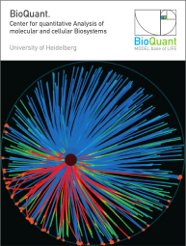Research Training Group: Mathematical Modeling for the Quantitative Biosciences (MMQB)
Mathematical models of neurogenesis - BioQuant_Marciniak-Czochra0116 [position filled]
Supervisor: Prof. Dr. Anna Marciniak-Czochra (BioQuant & Institute for Applied Mathematics)
Experimental partner: Prof. Dr. Ana Martin-Villalba (DKFZ)
Background and scientific question:
The focus of this project is modeling, analysis and simulation of dynamics of neuron production in the adult hippocampus. The dentate gyrus of the hippocampus harbors a niche of neural stem cells (NSC), capable of generating new neurons throughout adulthood. Although multiple studies have been conducted in the past to identify qualitative NSC features such as multi-potency or the age-related decline of the NSC pool, a quantitative understanding of the dynamics of adult neurogenesis is still missing. Recent experimental data point out the importance of specific regulatory feedbacks responsible for dynamical changes in the regeneration process. The feedbacks include Wnt signaling pathway and related antagonists such as Dkk1 and Sfrp3. Recent studies have also shown that neural stem cells are regulated by cell-to-cell contact-mediated Notch signaling, in addition to the recognized diffusible signaling such as that mediated by Wnt/Dkk1 (Seib et al. 2013). Moreover, recent RNA-seq data show that stem cells interact with environment while remaining in a quiescent state. The effects of spatial dimension in cell-to-cell communication and growth are observed also in other stem cell systems. Particularly interesting are cases in which the spatial interactions significantly influence the overall dynamics and lead to spatial patterns of cell behavior.
Project goal:
The aim of the project is to build a mathematical model to account for nonlinear feedback signaling underlying the age-related changes of hippocampal neurogenesis and to extend the models to describe spatio-temporal effects of cell-to-cell interactions. The models will be built and validated using data obtained in the laboratory of Ana Martin-Villalba (DKFZ). The new mathematical and computational tools will be applied to investigate mechanisms leading to stem cells depletion and astrocyte transformation in the course of aging process.
Planned work and collaboration within the RTG:
The point of departure for this project is a multi-compartment model developed in the PhD thesis of Frederik Ziebell (2015) validated using experimental data generated in the Martin-Villalba group and two other landmark studies on NSC dynamics conducted in the laboratories of Bonaguidi and of Encinas (Ziebell et al. 2014). The need to compare the population-level data with clonal data also required developing of a matching stochastic model. To extend models to spatial effects we employ two approaches: continuous partial differential equations models as well as individual-based models. Marciniak-Czochra group has extensive experience in modeling dynamical patterns in multicellular biological systems using partial and integro-differential equations to account for the transport of signaling factors, migration of cells or biomechanical interactions (eg. Marciniak-Czochra et al. 2013) and in modeling of nonlinear feedbacks and a resulting selection process (Stiehl et al. 2014, 2015). Concerning applications of the discrete or hybrid individual-based models the project will benefit from interactions with the Höfer and the Grabe Groups. To validate the new models, the group of Ana Martin-Villalba will generate new experimental data. These data include a clonal chase of stem cell progeny over several months, with the initial time point of the experiment also being age-dependent. This information will be used to account for the effects of aging. Furthermore, clonal chase will also be used to compare the wildtype and Dkk1 knockout groups, which will help to further characterize the Wnt/Dkk1 signaling pathway. Multiclonal dynamics will be investigated using stochastic models and simulated in collaboration with Ursula Kummer using the COPASI software.
Keywords:
Mathematical modeling, differential equations, neurogenesis, cell differentiation.
Profile of candidate’s qualification:
The candidate should have knowledge in the field of differential equations, skills to run numerical simulations and interested in an interdisciplinary work environment.
List of relevant publications:
1. Seib DR, Corsini NS, Ellwanger K, ...and Martin-Villalba A. (2013) Cell Stem Cell, 12: 204-214.
2. Ziebell F, Martin-Villalba A and Marciniak-Czochra A (2014) J. Royal Soc. Interface, 11: 20140144.
3. Stiehl T, Baran N, Ho A, Marciniak-Czochra A (2014) J. Royal Soc. Interface 11: 20140079
4. Stiehl T, Baran N, Ho A, Marciniak-Czochra A (2015) Cancer Research 75: 940-949.
5. Marciniak-Czochra A, Karch G, Suzuki K (2013), J. Math. Pures Appl. 99: 509-543.
Application: If you would like to apply for one of these PhD research projects, please click here and follow the instructions on the HBIGS website.


